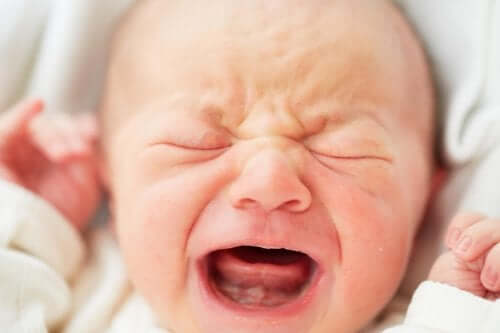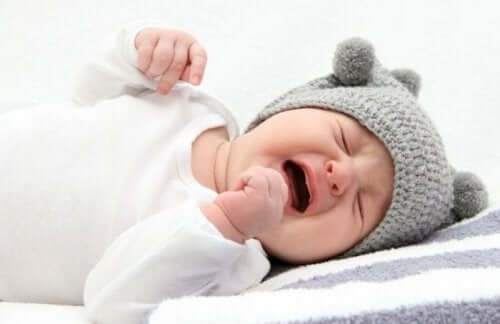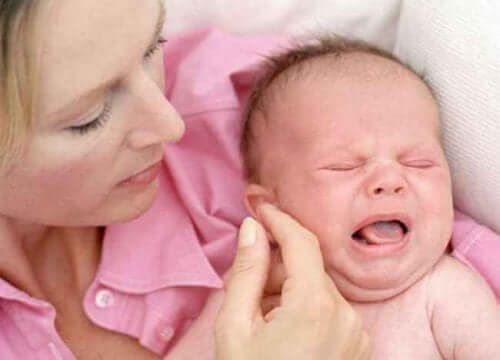Sobbing Spasms: When Crying Takes Your Breath Away


Written and verified by the psychologist Valeria Sabater
The spasms of sobbing or the apnea of crying mark that moment of authentic panic in which we see how our children cry so intensely that they even stop breathing or acquire a pale or purple hue.
Although it affects only 10% of children between the ages of 6 months and 3 years, the impact it causes on us when we see it is one that we can never forget. In fact, many moms have the distinct feeling that their babies are suffocating. Their lips are blue and it seems as if for a few seconds, they’re unable to breathe.
In fact, this is the case. Sobbing spasms are a type of infantile apnea related to a high emotional load. Most often, babies recover within 10 seconds with total normality, but after this experience, it’s common to see them somewhat more tired and even sleepy.
It’s important to clarify first that this is normal. It’s above all a physiological event that doesn’t usually last beyond three years and that, as mothers or as fathers, it’s important to know about.
In “You are Mom”, we’ll tell you all about it.
Sobbing spasms, a scare that’s hard to forget
A baby or 2-year-old will never do this on purpose to get attention. This is something that needs to be clarified first. It has nothing to do with whether or not the child is overprotected or receives excessive attention. To this day, there are still those who even think that children can cause the sobbing spasm just to attract the attention of their parents. Nothing could be further from the truth.
In fact, something interesting that’s worth remembering is that babies who suffer sobbing spasms usually inherit this trait from one of their parents. It’s a genetic behavior that can’t be controlled and that has to do above all with an uncontrolled emotional “explosion”.
Let’s look at it in detail.
The baby’s anger or frustration

Do our babies get angry? Certainly, and quite a bit. Emotions are those workhorses that completely dominate you to make you laugh out loud or cry your heart out. Some children do it with such intensity that when they suffer any “tantrum”, their still immature glottis causes them to experience apnea. In short, they stop breathing.
Most often, sobbing spasms occur in these situations:
- When the child is tired.
- When changing their diapers, feeding them, or during the bath.
- Late in the day, in the afternoon, or before going to sleep.
This type of disorder has a great impact on fathers and mothers, as they’re recurrent and uncontrollable at the same time. It doesn’t matter if you try to be more careful so that your little one doesn’t get upset, they’re still too small and their frustration will cause them to cry themselves out of breath for a few seconds.
- It’s common for them to become rigid, to take on a blue hue, and for us to see their mouths open in an almost agonizing spasm. After a few seconds, the child convulses and falls almost asleep, as if they’ve fainted.
- The impact is such that many parents tend to go to the emergency room in view of the awful moment they’ve experienced. Pediatricians advise us, and above all, they warn us of something that we must assume: Most likely, it will happen again.
What should I do when my child suffers a sobbing spasm?

- Stay calm, always remember that your baby is going to recover.
- Don’t intensify their emotional state, never shake your baby, shout, or let alone introduce anything into their mouth thinking drowning.
- Let them spend a few seconds doing nothing – even if it seems eternal – otherwise, you could aggravate the situation.
As we’ve indicated before, it’s not something that you can prevent. As the child matures, you can teach him to better manage his emotions. It’s a specific event that, as we say, doesn’t usually happen beyond 2 or 3 years of age.
At what point should I be concerned about this behavior?

In order to remain calm, always remember that the sequence of the apnea of crying follows these phases:
- Crying-apnea-stiffness-change of facial tonality-crying after 10 or 15 seconds, and then, drowsiness.
You need to go to the pediatrician in the case that your baby suffers from sobbing spasms when they’re less than 6 months old. Likewise, it’s not normal for this emotional apnea to last for almost a minute. If these types of episodes are very recurrent and last a long time, consult with a specialist.
To conclude, doctors recommend that we treat these cases normally. You should never worry about trying to avoid these situations. Excessive worry is never good, so it’s best to interact with your baby as usual, let them grow, mature, and little by little, help them manage these situations with patience and a lot of affection.
The spasms of sobbing or the apnea of crying mark that moment of authentic panic in which we see how our children cry so intensely that they even stop breathing or acquire a pale or purple hue.
Although it affects only 10% of children between the ages of 6 months and 3 years, the impact it causes on us when we see it is one that we can never forget. In fact, many moms have the distinct feeling that their babies are suffocating. Their lips are blue and it seems as if for a few seconds, they’re unable to breathe.
In fact, this is the case. Sobbing spasms are a type of infantile apnea related to a high emotional load. Most often, babies recover within 10 seconds with total normality, but after this experience, it’s common to see them somewhat more tired and even sleepy.
It’s important to clarify first that this is normal. It’s above all a physiological event that doesn’t usually last beyond three years and that, as mothers or as fathers, it’s important to know about.
In “You are Mom”, we’ll tell you all about it.
Sobbing spasms, a scare that’s hard to forget
A baby or 2-year-old will never do this on purpose to get attention. This is something that needs to be clarified first. It has nothing to do with whether or not the child is overprotected or receives excessive attention. To this day, there are still those who even think that children can cause the sobbing spasm just to attract the attention of their parents. Nothing could be further from the truth.
In fact, something interesting that’s worth remembering is that babies who suffer sobbing spasms usually inherit this trait from one of their parents. It’s a genetic behavior that can’t be controlled and that has to do above all with an uncontrolled emotional “explosion”.
Let’s look at it in detail.
The baby’s anger or frustration

Do our babies get angry? Certainly, and quite a bit. Emotions are those workhorses that completely dominate you to make you laugh out loud or cry your heart out. Some children do it with such intensity that when they suffer any “tantrum”, their still immature glottis causes them to experience apnea. In short, they stop breathing.
Most often, sobbing spasms occur in these situations:
- When the child is tired.
- When changing their diapers, feeding them, or during the bath.
- Late in the day, in the afternoon, or before going to sleep.
This type of disorder has a great impact on fathers and mothers, as they’re recurrent and uncontrollable at the same time. It doesn’t matter if you try to be more careful so that your little one doesn’t get upset, they’re still too small and their frustration will cause them to cry themselves out of breath for a few seconds.
- It’s common for them to become rigid, to take on a blue hue, and for us to see their mouths open in an almost agonizing spasm. After a few seconds, the child convulses and falls almost asleep, as if they’ve fainted.
- The impact is such that many parents tend to go to the emergency room in view of the awful moment they’ve experienced. Pediatricians advise us, and above all, they warn us of something that we must assume: Most likely, it will happen again.
What should I do when my child suffers a sobbing spasm?

- Stay calm, always remember that your baby is going to recover.
- Don’t intensify their emotional state, never shake your baby, shout, or let alone introduce anything into their mouth thinking drowning.
- Let them spend a few seconds doing nothing – even if it seems eternal – otherwise, you could aggravate the situation.
As we’ve indicated before, it’s not something that you can prevent. As the child matures, you can teach him to better manage his emotions. It’s a specific event that, as we say, doesn’t usually happen beyond 2 or 3 years of age.
At what point should I be concerned about this behavior?

In order to remain calm, always remember that the sequence of the apnea of crying follows these phases:
- Crying-apnea-stiffness-change of facial tonality-crying after 10 or 15 seconds, and then, drowsiness.
You need to go to the pediatrician in the case that your baby suffers from sobbing spasms when they’re less than 6 months old. Likewise, it’s not normal for this emotional apnea to last for almost a minute. If these types of episodes are very recurrent and last a long time, consult with a specialist.
To conclude, doctors recommend that we treat these cases normally. You should never worry about trying to avoid these situations. Excessive worry is never good, so it’s best to interact with your baby as usual, let them grow, mature, and little by little, help them manage these situations with patience and a lot of affection.
All cited sources were thoroughly reviewed by our team to ensure their quality, reliability, currency, and validity. The bibliography of this article was considered reliable and of academic or scientific accuracy.
- Ruiz-García, M. (2014). Espasmo del sollozo. Acta pediátrica de México, 35(2), 166-169. http://www.scielo.org.mx/scielo.php?pid=S0186-23912014000200011&script=sci_arttext&tlng=en
- Bernztein, R. (2001). Espasmo del sollozo. Medicina Infantil, 8(4). https://www.medicinainfantil.org.ar/images/stories/volumen/2001/viii_4_297.pdf
- Matilde, R. G. (2014). Espasmo del sollozo. Acta Pediátrica de México, 35(2), 166-169. https://ojs.actapediatrica.org.mx/index.php/APM/article/view/691
This text is provided for informational purposes only and does not replace consultation with a professional. If in doubt, consult your specialist.








